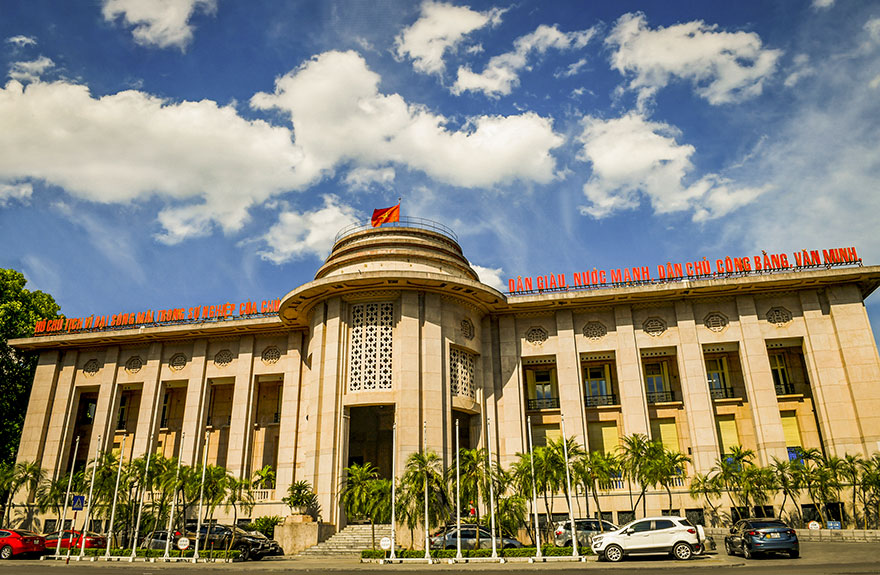MONETARY POLICY MANAGEMENT AND BANKING ACTIVITIES ACHIEVE MANY POSITIVE RESULTS

MONETARY POLICY MANAGEMENT AND BANKING ACTIVITIES ACHIEVE MANY POSITIVE RESULTS
Source: Collected
Recently, on December 24, 2020, the State Bank of Vietnam (SBV) held a press conference to deploy the tasks of the banking sector in 2021. Deputy Secretary of the Party Committee, Permanent Deputy Governor of the SBV Dao Minh Tu chaired the press conference. At the press conference, representatives of the leaders of the SBV's Departments and Bureaus informed about some results of monetary policy management and banking activities in 2020, and orientations for tasks in 2021.
Monetary policy management contributes to macroeconomic stability
Speaking at the press conference, SBV Deputy Governor Dao Minh Tu said that the SBV identified 2020 as an extremely important year, decisive in implementing the 5-year plan goals. Therefore, closely following the policies of the National Assembly, the Government and developments in the macro economy and domestic and foreign markets, in 2020, the SBV has operated monetary policy proactively, flexibly, cautiously, closely coordinating with fiscal policy and other macroeconomic policies to control inflation, stabilize the macro economy, the money and foreign exchange markets, and support economic recovery in the face of complicated developments of the Covid-19 pandemic.

At the same time, the SBV directed credit institutions to resolutely implement measures to cope with the impact of the pandemic; support businesses and people to overcome difficulties caused by Covid-19 and floods to soon recover production and business; continue to resolutely implement restructuring work associated with bad debt handling. Thanks to that, despite being heavily affected by the pandemic, monetary policy management and banking operations still achieved many positive results in all aspects of operation.
In 2020, the State Bank of Vietnam (SBV) has operated monetary policy proactively, flexibly, and cautiously, closely coordinating with fiscal policy and other macroeconomic policies to control inflation, stabilize the macro-economy, the money and foreign exchange markets, and support economic recovery in the face of complicated developments of the Covid-19 pandemic. At the same time, it directed credit institutions to resolutely implement measures to respond to the impact of the pandemic; support businesses and people to overcome difficulties caused by Covid-19 and floods to soon restore production and business; continue to resolutely implement restructuring work associated with bad debt handling. Thanks to that, despite being heavily affected by the pandemic, monetary policy management and banking operations still achieved many positive results in all aspects of operation. Specifically: By December 18, 2020, total M2 means of payment increased by 12.83% compared to the end of 2019 and increased by 14.62% compared to the same period in 2019. Liquidity of the credit institution system is smooth.
Regarding interest rate management: In general, from the beginning of 2020 to now, the State Bank has adjusted interest rates 3 times with a total reduction of 1.5-2.0%/year in operating interest rates (one of the central banks with the largest reduction in operating interest rates in the region); reduced the deposit interest rate ceiling by 0.6-1.0%/year; reduced the lending interest rate ceiling by 1.5%/year for priority sectors. At the same time, it directed credit institutions to save costs and sharply reduce lending interest rates, especially for priority sectors. As a result, as of November 2020, the lending interest rate level decreased by an average of about 1%/year compared to the end of 2019; the maximum short-term lending interest rate in VND for a number of priority sectors and fields was at 4.5%/year.
Regarding exchange rate management, the State Bank of Vietnam operates and announces the central exchange rate flexibly every day in accordance with market developments, macroeconomic and monetary balances, and monetary policy targets. The USD/VND exchange rate moves in accordance with market conditions and fluctuations of the USD in the world market.
Regarding credit management: The State Bank proactively and reasonably manages credit growth in accordance with the absorption level of the economy, focusing on production - business, consumption, and priority sectors, according to the Government's policy, contributing significantly to restoring production and business activities and maintaining economic growth after the pandemic. Credit for risky sectors is strictly controlled. Credit institutions have implemented many lending programs with preferential interest rates. Due to weakened credit demand due to the negative impact of the Covid-19 pandemic, credit growth is lower than in previous years. By December 21, 2020, credit increased by 10.14% compared to the end of 2019, up 11.62% over the same period in 2019.
To support customers in overcoming difficulties caused by the pandemic, implementing the Government's direction, the banking sector has taken action very early and issued two important documents, Circular 01/2020/TT-NHNN and Directive 02/CT-NHNN, directing credit institutions to restructure debt repayment terms, waive and reduce interest and fees, and maintain debt groups for customers affected by the Covid-19 pandemic; reduce operating costs to create conditions for maximum interest rate reduction; promote non-cash payments (TTKDTM), diversify appropriate credit programs and products, and promote administrative procedure reform, apply technology to limit direct transactions while still creating conditions for customers to easily access credit and banking services.
To date, credit institutions have restructured the repayment period for about 270,000 customers affected by the Covid-19 epidemic with outstanding loans of nearly VND 355,000 billion; exempted, reduced, and lowered interest rates for nearly 590,000 customers with outstanding loans of over VND 1 million billion, especially credit institutions have provided new loans with preferential interest rates (commonly 0.5 - 2.5% lower than before the epidemic) with accumulated sales from January 23 to now reaching nearly VND 2.3 million billion for more than 390,000 customers. Although not subject to Circular 01, the People's Credit Fund has extended debt repayment for nearly 168,000 customers with outstanding loans of VND 4,183 billion, and provided new loans to over 2 million customers with an amount of VND 72,531 billion.
It is estimated that the total amount of payment service fees that banks exempt or reduce for customers by the end of 2020 after 2 fee reductions is about 1,004 billion VND. The growth of e-commerce has reached an impressive rate with many targets meeting and exceeding requirements. By the end of October 2020, the number of payment transactions via mobile phones reached more than 918.8 million transactions with a value of nearly 9.6 million billion VND (an increase of 123.9% in quantity and 125.4% in value compared to the same period in 2019); the number of payment transactions via the Internet reached nearly 374 million transactions with a value of more than 22.2 million billion VND (an increase of 8.3% in quantity and 25.5% in transaction value compared to the same period in 2019). Compared to the same period in 2016, in the first 10 months of 2020, transactions via the Interbank Electronic Payment System (IBS) increased by 83.67% in quantity and 135.04% in value; the quantity and value of payments via the Internet channel increased by 276.4% and 343%; the quantity and value of payments via mobile phone channels increased by 1,037% and 972.5%. Payment activities via banks for public services have been promoted, meeting the budget collection and expenditure needs of people and businesses quickly and promptly. To date, 99% of enterprises have registered to pay taxes electronically; 98.6% of the total State Budget revenue of customs agencies is made electronically; Vietnam Electricity Group's electricity revenue paid through banks is up to nearly 90%... The legal framework for payment activities continues to be reviewed, supplemented and creates more favorable conditions for the development of e-commerce.
Administrative reform (PAR), improvement of the business investment environment, and enhancement of competitiveness continued to achieve positive results. The State Bank of Vietnam continued to lead the ministries and branches in the PAR index in 2019 and for the 5th consecutive year it has ranked first among ministries and ministerial-level agencies. Vietnam's credit access index ranked 25/190 countries and territories, up 7 places compared to Doing Business 2019 and ranked 2nd in the ASEAN region, 2nd in the Asia region (after Brunei), completing the target of increasing at least one place as required by the Government.
The restructuring of the credit institution system has achieved important results according to the objectives and roadmap set out in Project 1058. Financial capacity, governance and operational efficiency, safety indicators, and transparency in the operations of credit institutions have been significantly improved and are increasingly approaching international practices and standards. The implementation of Basel II continues to be focused on by credit institutions to meet international practices on capital safety.
Bad debts are controlled and handled drastically with many solutions, in which debt collection solutions are implemented by credit institutions with positive results, proving the correctness and effectiveness of Resolution 42. Although by the end of October 2020, the bad debt ratio on the balance sheet exceeded 2%, this is an objective necessity and demonstrates the great efforts of the banking industry in the context of the economy being severely affected by the Covid-19 pandemic and customers' ability to repay debts being reduced.
These results have helped to improve the ranking prospects of Vietnamese credit institutions in recent years and in 2020, 14 Vietnamese commercial banks were in the list of Top 500 largest and strongest banks in Asia-Pacific and the Bank for Foreign Trade (Vietcombank) ranked 29/500, up 19 places compared to the 2017 ranking. These are very encouraging results, creating a solid foundation for the Vietnamese banking system to develop safely and sustainably in the future.
Mission orientation for 2021
Answering questions and clarifying issues of concern to reporters, Permanent Deputy Governor Dao Minh Tu said that, based on the goals of the National Assembly, the Government and domestic and foreign macroeconomic and monetary developments, the State Bank of Vietnam will continue to operate monetary policy proactively and flexibly in harmony with fiscal policy and other macroeconomic policies to control inflation; maintain macroeconomic and market stability, and support rapid economic recovery, specifically:
(i) Actively and flexibly manage monetary policy (especially interest rates and exchange rates) in accordance with macroeconomic balance, market developments and monetary policy targets, ensuring a stable and smooth monetary and foreign exchange market;
(ii) Directing credit institutions to continue to thoroughly cut costs to reduce lending interest rates, simplify procedures, create conditions for new borrowers to restore production and business but not lower lending standards, ensure credit quality and safety, and maintain healthy operations of the banking system;
(iii) Continue to manage credit in the direction of effectively expanding credit, focusing on lending to priority sectors and production and business sectors, while at the same time, strictly controlling credit for sectors with potential risks, improving credit quality and efficiency;
(iv) Develop and submit to the Government a master plan for restructuring credit institutions for the 2021-2025 period and direct credit institutions to proactively develop their own restructuring plans for early implementation in the coming time;
(v) Continue to improve the legal framework and develop and implement the Project for developing e-commerce in the coming period, focusing on improving the infrastructure for e-commerce; promoting innovation and applying achievements of the 4th Industrial Revolution in payment activities; Deploying payment models in rural, remote and isolated areas in conjunction with the development and implementation of the National Financial Inclusion Strategy; Strengthening information and communication on e-commerce and financial education; strengthening measures to protect consumer rights, while improving the quality and efficiency of payment services.
Register for admission consultation 2025
scholarships and tuition support worth up to 55 billion VND

scholarships and tuition support worth up to 55 billion VND






